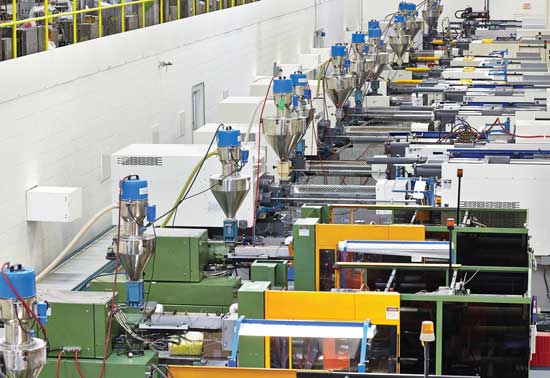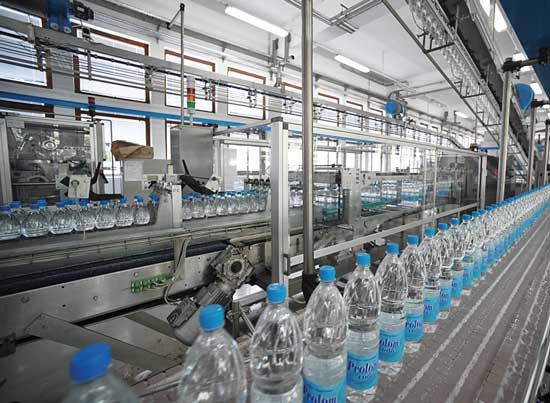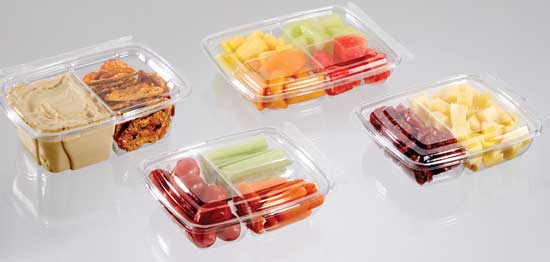Innovations in Plastic Food Packaging
PACKAGING
The machinery and materials for producing plastic packaging are advancing to meet brand owner, consumer, and postconsumer needs. Packages made with plastic dominate primary food packaging. Cost, transparency, sustainability, food safety, and tailored oxygen and water vapor barriers make plastic an attractive choice. Innovations in the manufacturing of plastic packaging manufacturing are focused on delivering enhanced food safety, enabling agility, lower cost, and more sustainable packaging.
 Food Safety
Food Safety
The connection between safe packaging and food safety is strong. Most packaging suppliers for the food industry are GFSI-certified. There is a need for higher assurances to eliminate contamination while processing plastic from resin into containers, to ensure process limits are in place to control migration, and to restrict contamination before containers are filled. In addition, as packaging materials are optimized for high-speed production and costs, package tolerances have tightened. This need for higher process controls, optimization, and tolerances has prompted interest in ISO/TS 16949 certification for packaging suppliers. There is a higher degree of process control for a company that is ISO/TS 16949–certified than for one that is not certified. Increased ISO/TS 16949 certification in the food packaging industry translates to greater quality management and defect prevention. “Our TS 16949 certification ensures that a single part out of millions can be traced back to the onset of a defect. This can pinpoint or, more importantly, allow us to prevent packaging defects in manufacturing that are often associated with food safety recalls,” says John Angell, director of sales packaging at Novation Industries, McHenry, Ill. (novationindustries.com). The ability to trace efficiently permits potential Failure Mode and Effects Analysis to reduce risk. Novation has found that a tightened chain of custody optimizes new customer relationships and builds trust. As molding innovations, speed, and resin sources are optimized, consistency is needed to ensure food safety for injection-molded thermoformed blow-molded containers and film. Certifications such as ISO/TS 16949 by packaging suppliers are becoming a means of competitive advantage and allowing process evolution to focus on food safety.
 Another risk of contamination is between plastic processing into containers and the filling operation at food manufacturers. The link between packaging and food safety is tightening as machines that produce, fill, and then seal a package are expanding into plastic packaging for the food industry. Containers have been thermoformed, filled, and sealed in horizontal machines for quite some time at Reiser, Canton, Mass. (reiser.com), and Multivac, Wolfertschwenden, Germany (multivac-group.com). Recent innovations allow other container types to be made and filled at the same time; this eliminates contamination and lowers energy costs of empty container transport. For example, the Matrix Combi blow-fill-cap operation by Sidel, Hünenberg, Switzerland (sidel.com), inherently reduces contamination and energy consumption since bottles are produced, filled, and capped within a single high-efficiency particulate air filtered enclosure. For a Prolom mineral-water product packaged on this machine, the amount of plastic in each bottle was reduced due to the handling process on a 13,200 bottles-per-hour production line. Eliminating the extra handling of empty containers means that less plastic is needed in the bottle. Another recent innovation is Liquiform, by Amcor, Melbourne, Australia (amcor.com), a joint venture with Sidel that uses consumable, pressurized liquid to produce containers. The blow-fill-seal innovation challenges other machinery manufacturers to pursue similar technology to reduce the potential for contamination and optimize the package for retail and consumers.
Another risk of contamination is between plastic processing into containers and the filling operation at food manufacturers. The link between packaging and food safety is tightening as machines that produce, fill, and then seal a package are expanding into plastic packaging for the food industry. Containers have been thermoformed, filled, and sealed in horizontal machines for quite some time at Reiser, Canton, Mass. (reiser.com), and Multivac, Wolfertschwenden, Germany (multivac-group.com). Recent innovations allow other container types to be made and filled at the same time; this eliminates contamination and lowers energy costs of empty container transport. For example, the Matrix Combi blow-fill-cap operation by Sidel, Hünenberg, Switzerland (sidel.com), inherently reduces contamination and energy consumption since bottles are produced, filled, and capped within a single high-efficiency particulate air filtered enclosure. For a Prolom mineral-water product packaged on this machine, the amount of plastic in each bottle was reduced due to the handling process on a 13,200 bottles-per-hour production line. Eliminating the extra handling of empty containers means that less plastic is needed in the bottle. Another recent innovation is Liquiform, by Amcor, Melbourne, Australia (amcor.com), a joint venture with Sidel that uses consumable, pressurized liquid to produce containers. The blow-fill-seal innovation challenges other machinery manufacturers to pursue similar technology to reduce the potential for contamination and optimize the package for retail and consumers.
 Enabling Agility
Enabling Agility
Agility in processing plastics permits new materials, additives, and fillers to be assessed; new technology to be integrated; and optimized production processes to meet the essentials of the final container. For brand owners this agility results in lower costs, tighter process controls to enable high-speed manufacturing, and a shorter time to market. Innovations in polymer production processes have increased agility. “Lacerta’s ability to design and build prototype/production molds and extrude/laminate polymer sheets for thermoform packages in a cleanroom appeals to compressed food industry project timelines. We have produced containers for production in less than two weeks,” says Ali Lotfi, president of Lacerta Group, Mansfield, Mass. (lacerta.com). Normal timing for production thermoform molds can be 10 weeks, and there are often handoffs between designers to mold fabricators and polymer sheet manufacturers and to a packaging company that result in miscommunication. Lacerta eliminates the lead time associated with these steps, making their designs successful and timely.
Lacerta’s agility is intentional and provides a competitive advantage in both quality and speed. In addition, Lacerta’s method of preprocessing postconsumer recycled polymers (i.e., using filters and volatile reduction processes) reduces actual extrusion resonance time. This reduction in time helps improve the strength of containers since less additives need to be used and less polymer degradation occurs during the extrusion process. As polymers evolve, pilot-scale facilities within packaging manufacturers are increasing to allow for application of new polymer research. With three thermoform machines dedicated to prototype development supported by a team of designers, Lacerta can assess what is needed to produce packaging from new polymers, fillers, and process additives rapidly.
Lower Cost and More Sustainability
Lamy Chopin, global development leader for packaging and specialty plastics at Dow Chemical Co., Midland, Mich. (dow.com), explains what drives innovation in polymer processing at Dow: “Two key drivers are enhanced offerings at a reduced cost and sustainability.” Interest in enhancement at a lower cost translates to better seal integrity, barriers, colors, and printability and the use of intelligent and active packaging for an enhanced consumer experience. One solution is multilayer plastic extrusion machinery that is capable of 11 layer extrusions. Layers are optimized to provide the best solution for specific needs. Technology from Dow can help optimize the properties of each layer in packaging structures so that less resources are used, which reduces packaging waste. However, recycling the multilayer packaging is often not economically or technically viable. The economical recapture of energy has been a challenge for multilayer packaging even though multilayer packaging is inherently sustainable in terms of material use. In Europe, for example, the fee for multilayer packaging is the highest since the cost to handle multilayer packaging after consumer use is high. However, the volume of flexible packaging, which is often multilayered, is now double that of rigid plastic packaging containers in Europe. Recent advances in polymer process machinery are providing solutions. For example, processes by Plastigram Industries, Prague, The Czech Republic (plastigram.eu), use patented solvent-based technology licensed from the Czech Academy of Sciences to recapture energy from multilayer packaging.
“Dow’s holistic approach to sustainability is to decrease material use and increase recycling. An example of Dow’s vision of a circular economy is being explored by expanding their value chain into package recovery,” Chopin explains. In 2014, the Energy Bag recycling program in Citrus Heights, Calif., facilitated the identification and separation of juice pouches, candy wrappers, and other multilayer packaging to be turned into energy. This effort has been expanded to Omaha, Neb., through a partnership between Dow, Reynolds Consumer Products, Recyclebank, First Star Recycling, ConAgra Foods, and Systech Environmental Corp. Because of this program, the volume of multilayer packaging collected has increased and processes for pyrolysis are advancing. The recovery loop is also closing due to efforts by Materials Recovery for the Future, sponsored by companies such as Dow, PepsiCo, Procter & Gamble, Nestlé USA, and Sealed Air. These partnerships are an example of how the packaging industry is approaching sustainability. As developments in recycled polymer pyrolysis to generate energy such as diesel and naphtha evolve, Dow could actually use the regenerated naphtha to produce polyethylene. The investment in creating a circular economy in which a package is used to produce another package material is being explored by many packaging suppliers.
Polymer additives increase the recycling rates of polyethylene plastic packaging. A minimal barrier such as polyethylene is often layered with an exception oxygen barrier ethylene vinyl alcohol (EVOH) in a package. But the recycling of polyethylene containing a thin layer of EVOH has not been viable. Dow’s RecycleReady technology enables recycling of polyethylene-EVOH layers. “This means increased use of recycled polyethylene, reduced costs/risk of recycling polyethylene for recyclers, and consumer ease of recycling for polyethylene-EVOH,” Chopin points out.
Polymer additives are also aiding package manufacturing. For example, the addition of calcium carbonate (talc), silica, and clay in plastic containers increases rigidity, heat resistance, barrier properties, and solvent resistance while lowering cost. When plastic is replaced by the filler, less plastic is used and recycling is typically not affected. The addition of talc reduces the amount of plastic needed in a container to impart the needed rigidity. Mistrocell talc by Imerys, Paris (imerys.com), increases cell density and reduces foam cell size, which results in higher stiffness in foam packaging. Less plastic is needed for the same stiffness. For bioderived plastic, fillers aid in crystallization and are integral to being able to efficiently form the containers. There is also much development in the use of compatible fillers such as conductive fillers of aluminum powders, carbon fiber, and graphite for active and intelligent packaging applications.
 Claire Koelsch Sand, PhD, Contributing Editor
Claire Koelsch Sand, PhD, Contributing Editor
President, Packaging Technology & Research
Adjunct Professor,
Michigan State Univ.
[email protected]
